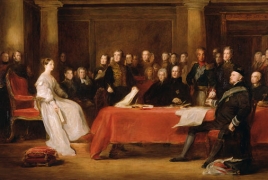New exhibit presents Scottish masterpieces acquired over 250 years March 19, 2016 - 20:51 AMT PanARMENIAN.Net - The finest Scottish works from the Royal Collection acquired by monarchs since George III went on display in a new exhibition opening (Friday, 18 March) at The Queen's Gallery, Buckingham Palace. Scottish Artists 1750 – 1900: From Caledonia to the Continent brings together over 80 works of art by some of Scotland's most celebrated artists, including Allan Ramsay and Sir David Wilkie. From romantic Highland views to vibrant Spanish street scenes, the exhibition shows the range of subjects and styles adopted by Scottish artists in the 18th and 19th centuries, Art Daily said. Allan Ramsay was the first Scot to be appointed to the royal role of Principal Painter in Ordinary and was commissioned to paint George III's State Portrait following the King's accession in 1760. As well as producing what was to become the most widely copied image of the King, Ramsay painted several portraits of members of the royal family, including Queen Charlotte with her Two Eldest Sons, 1764-9, considered to be one of the artist's most distinguished and elegant works. The exhibition includes 21 works by Scotland's most celebrated artist, Sir David Wilkie, including his first royal commissions, Blind-Man’s-Buff, 1812, and The Penny Wedding, 1818. Painted for George IV, the two works undoubtedly sealed Wilkie's reputation as one of the leading artists of the 19th century. The King also commissioned the artist to record his historic visit to Edinburgh in 1822. The Entrance of George IV to Holyroodhouse, 1822–30, shows the King being presented with the keys to the Palace while crowds of enthusiastic spectators clamber over every part of the building to see him. Wilkie was appointed Principal Painter in Ordinary to the King in 1830 and retained the post until his death in 1841, serving under both William IV and Queen Victoria. An oil sketch by Wilkie is the earliest known image of Victoria as reigning monarch, made just four months after her accession to the throne at the age of 18. It is a study for Wilkie's painting The First Council of Queen Victoria, 1838, the first picture commissioned by Victoria as Queen. Initially Victoria was pleased with the painting, but she came to dislike it and later described it as ‘one of the worst pictures I have ever seen, both as to painting & likeness’. The Queen acquired only two further works by Wilkie, including a painting of Abd-ul-Mejid, the Sultan of Turkey, created during the artist's stay in Constantinople in 1840 and one of his last works. Prince Albert and Queen Victoria were shown James Giles's images of Balmoral during negotiation of the lease in 1848 – they had never seen the estate themselves. Immediately following the acquisition of the estate, the Queen commissioned the artist to paint A View of Balmoral,1848 and A View of Lochnagar, 1848 as Christmas presents for Prince Albert, together with five watercolours by the artist. In the mid-19th century the growing interest in foreign cultures encouraged artists to seek inspiration abroad. David Roberts was the first independent professional artist to travel extensively in the Middle East. Paintings such as A View in Cairo, 1840, which shows the medieval Gate of Zuweyleh, introduced the British public to views of the region for the first time. John Phillip, Queen Victoria's favourite Scottish artist, was renowned for his colourful depictions of Spanish street life. Victoria commissioned Phillip's A Spanish Gypsy Mother, 1852, and purchased 'El Paseo', 1854, for Prince Albert. The Prince gave the Queen The Letter Writer of Seville, 1854, for Christmas. After a visit to the Royal Academy in 1858, Victoria acquired The Dying Contrabandista, 1858, as a Christmas gift for the Prince. Royal interest in and acquisition of Scottish works of art have continued into the 20th and 21st centuries. The Duke and Duchess of York (later King George VI and Queen Elizabeth) were presented with a magnificent large-scale musical pedestal clock,1800–08, by the Scottish clockmaker John Smith on the occasion of their marriage in 1923. In 2003Her Majesty The Queen acquired a preparatory sketch for Sir David Wilkie's painting Blind-Man's-Buff. Exhibition curator Deborah Clarke of Royal Collection Trust said, 'This exhibition brings together a large group of significant works that have not been seen together in London before. It is a fascinating reflection of the Monarchy's long association with artists from Scotland, an interest that has continued until the present day.' Photo: Her Majesty Queen Elizabeth II 2016. The creative crew of the Public TV had chosen 13-year-old Malena as a participant of this year's contest. She called on others to also suspend their accounts over the companies’ failure to tackle hate speech. Penderecki was known for his film scores, including for William Friedkin’s “The Exorcist”, Stanley Kubrick’s “The Shining”. The festival made the news public on March 19, saying that “several options are considered in order to preserve its running” Partner news |